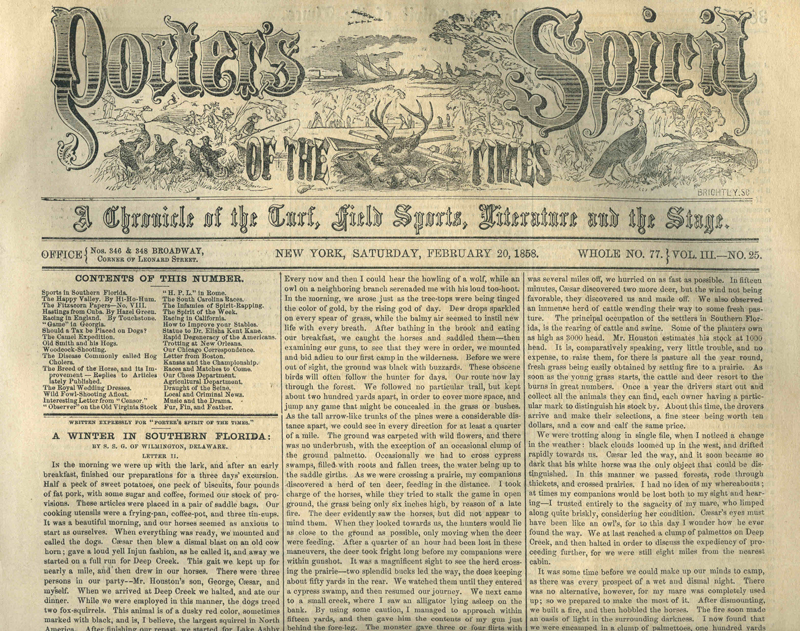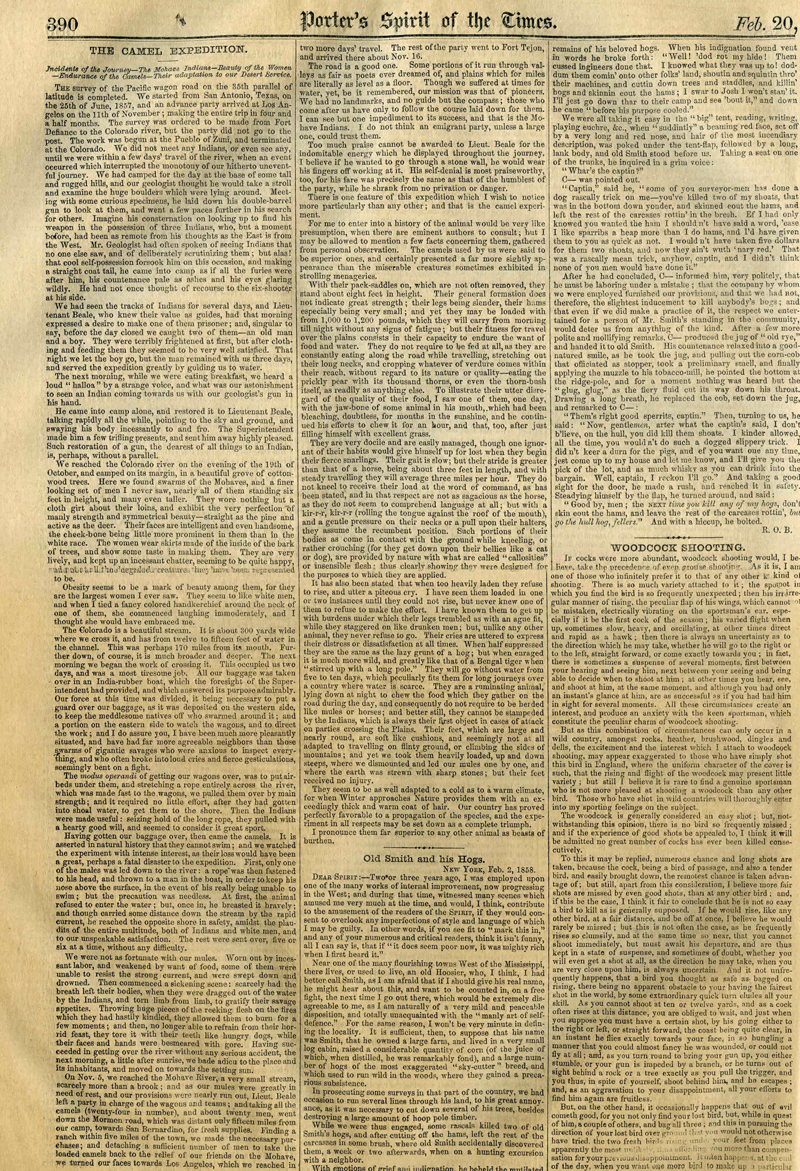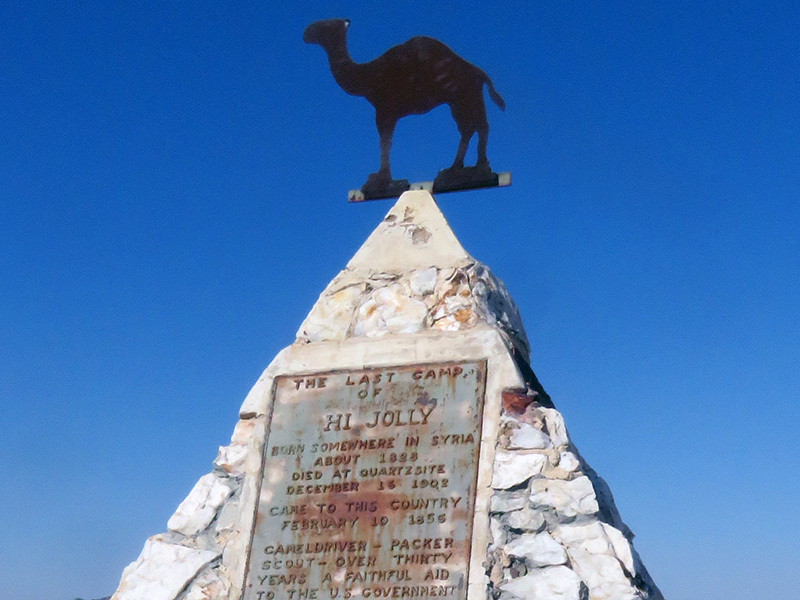THE CAMEL EXPEDITION.
Incidents of the Journey—The Mohave Indians—Beauty of the Women—Endurance of the Camels—Their adaptation to Our Desert Service.
The Survey of the Pacific wagon road on the 85th parallel of
latitude is completed. We started from San Antonio, Texas, on the 25th of June 1857, and an advance party arrived at Los Angeles on the 11th of November; making the entire trip in four and a half months. The survey was ordered to he made from Fort Defiance to the Colorado river, but the party did not go to the post. The work was begun at the Pueblo of Zuni, and terminated at the Colorado. We did not meet any Indians, or even see any, until we were within a few days' travel of the river, when an event occurred which interrupted the monotony of our hitherto uneventful journey. We had camped for the day at the base of some tall and rugged hills, and our geologist thought be would take a stroll and examine the huge boulders which were lying around. Meeting with some curious specimens, he laid down his double-barrel gun to look at them, and went a few paces further in his search for others. Imagine his consternation on looking up to find his weapon in the possession of three Indians, who, but a moment before, had been as remote from his thoughts as the last is from the West. Mr. Geologist had often spoken of seeing Indians that no one else saw, and of deliberately scrutinizing them; but alas that cool self-possession forsook him on this occasion, and making a straight coat tail, he came into camp as if all the furies were after him, his countenance pale as ashes and his eyes glaring wildly. He had not once thought of recourse to the six-shooter at his side.
We had seen the tracks of Indians for several days, and Lieu-
tenant Beale, who knew their value as guides, had that morning expressed a desire to make one of them prisoner; and, singular to say, before the day closed we caught two of them—an old man and a boy. They were terribly frightened at first, but after clothing and feeding them they seemed to be very well satisfied. That night we let the boy go, but the man remained with us three days, and served the expedition greatly by guiding us to water.
The next morning, while we were eating breaktkst, we heard a loud " halloa " by a strange voice, and what was our astonishment to seen an Indian coming towards us with our geologist's gun in his hand.
He came into camp alone, and restored it to Lieutenant Beale,
talking rapidly all the while, pointing to the sky and ground, and swaying his body incessantly to and fro. The Superintendent made him a few trifling presents, and sent him away highly pleased, Such restoration of a gun, the dearest of all things to an Indian, is, perhaps, without a parallel.
We reached the Colorado river on the evening of the 19th of
October, and camped on its margin, in a beautiful grove of cottonwood trees. Here we found swarms of the Mohaves, and a finer looking set of men I never saw, nearly all of them standing six feet in height, and many even taller. They wore nothing but a cloth girt about their loins, and exhibit the very perfection of manly strength and symmetrical beauty—straight as the pine and active as the deer. Their faces are intelligent and even handsome, the cheek-bone being little more prominent in them than in the white race. The women wear skirts made of the inside of the bark of trees, and show some taste in making them. They are very lively, and kept up an incessant chatter, seeming to be quite happy, and not at all the degraded creatures they have been represented to be.
Obesity seems to be a mark of beauty among them, for they
are the largest women I ever saw. They seem to like white men, and when I tied a fancy colored handkerchief around the neck of one of them, she commenced laughing immoderately, and I thought she would have embraced me.
The Colorado is a beautiful stream. It is about 300 yards wide
where we cross it, and has from twelve to fifteen feet of water in the channel. This was perhaps 170 miles from its mouth. Further down, of course, it is much broader and deeper. The next morning we began the work of crossing it, This occupied us two days, and was a most tiresome job. All our baggage was taken over in an India-rubber boat, which the foresight of the Superintendent had provided, and which answered its purpose admirably. Our force at this time was divided, it being necessary to put a guard over our baggage, as it was deposited on the western side, to keep the meddlesome natives off who swarmed around it; and a portion on the eastern side to watch the wagons, and to direct the work; and I do assure you, I have been much more pleasantly situated, and have had far more agreeable neighbors than those swarms of gigantic savages who were anxious to inspect everything, and who often broke into loud cries and fierce gesticulations, seemingly bent on a fight.
The modus operandi of getting our wagons over, was to put air-
beds under them, and stretching a rope entirely across the river, which was made fast to the wagons, we pulled them over by main strength; and it required no little effort, after they had gotten into shoal water, to get them to the shore. Then the Indians were made useful: seizing hold of the long rope, they pulled with a hearty good will, and seemed to consider it great sport.
Having gotten our baggage over, then came the camels. It is
asserted in natural history that they cannot swim; and we watched the experiment with intense interest, as their loss would have been a great, perhaps a fatal disaster to the expedition. First, only one of the males was led down to the river: a rope was then fastened to his head, and thrown to a man in the boat, in order to keep his nose above the surface, in the event of his really being unable to swim; but the precaution was needless. At first, the animal refused to enter the water; but, once in, he breasted it bravely; and though carried some distance down the stream by the rapid current, he reached the opposite shore in safety, amidst the plaudits of the entire multitude, both of Indians and white men, and to our unspeakable satisfaction. The rest were sent over, five or six at a time, without any difficulty.
We were not as fortunate with our mules. Worn out by inces-
sant labor, and weakened by want of food, some of them were unable to resist the strong current, and were swept down and drowned. Then commenced a sickening scene: scarcely had the breath left their bodies, when they were dragged out of the water by the Indians, and torn limb from limb, to gratify their savage appetites. Throwing huge pieces of the reeking flesh on the fires which they had hastily kindled, they allowed them to burn for a few moments; and then, no longer able to refrain from their horrid feast, they tore it with their teeth like hungry dogs, while their faces and hands were besmeared with gore. Having succeeded in getting over the river without any serious accident, the next morning, a little after sunrise, we bade adieu to the place and its inhabitants, and moved on towards the setting sun.
On Nov. 5, we reached the Mohave River, a very small stream, scarcely more than a brook; and as our mules were greatly in
need of rest, and our provisions were nearly run out, Lieut. Beale left a party in charge of the wagons and teams; and taking all the camels (twenty-four in number), and about twenty men went down the Mormon road, which was distant only fifteen mile's from our camp, towards San Bernardino, for fresh supplies. Finding a ranch within five miles of the town, we made the necessary purchases; and detaching a sufficient number of men to take the loaded camels back to the relief of our friends on the Mohave we turned our faces towards Los Angeles, which we reached in two more days' travel. The rest of the party went to Fort Tejon, and arrived there about Nov. 16.
The road is a good one. Some portions of it run through valleys as fair as poets ever dreamed of and plains which for miles are literally as level as a floor. Though we suffered at times for water yet, be it remembered, our mission was that of pioneers. We had no landmarks, and no guide but the compass; those who come after us have only to follow the course laid down for them. I can see but one impediment to its success, and that is the Mohave Indians. I do not think an emigrant party, unless a large one, could trust them.
Too much praise cannot be awarded to Lieut. Beale for the indomitable energy which he displayed throughout the journey. I believe if he wanted to go through a stone wail, he would wear his fingers off working at it. His self-denial is most praiseworthy, too, for his fare was precisely the same as that of the humblest of the party, while he shrank from no privation or danger.
There is one feature of this expedition which I wish to notice more particularly than any other; and that is the camel experiment.
For me to enter into a history of the animal would be very like presumption, when there are eminent authors to consult; but I may be allowed to mention a few facts concerning them, gathered from personal observation. The camels used by us were said to be superior ones, and certainly presented a far more sightly appearance than the miserable creatures sometimes exhibited in strolling menageries.
With their pack-saddles on, which are not often removed, they stand about eight feet in height. Their general formation does not indicate great strength; their legs being slender, their hams especially being very small; and yet they may be loaded with from 1,000 to 1,200 pounds, which they will carry from morning till night without any signs of fatigue; but their fitness for travel over the plains consists in their capacity to endure the want of food and water. They do not require to be fed at all, as they are constantly eating along the road while travelling, stretching out their long necks, and cropping whatever of verdure comes within their reach, without regard to its nature or quality—eating the prickly pear with its thousand thorns, or even the thorn-bush itself, as readily as anything else. To illustrate their utter disregard of the quality of their food, I saw one of them, one day, with the jaw-bone of some animal in his mouth, which had been bleaching, doubtless, for months in the sunshine, and he continued his efforts to chew it for an hour, and that, too, after just filling himself with excellent grass.
They are very docile and are easily managed, though one ignorant of their habits would give himself up for lost when they begin their fierce snarlings. Their gait is slow; but their stride is greater than that of a horse, being about three feet in length, and with steady travelling they will average three miles per hour. They do not kneel to receive their load at the word of command, as has been stated, and in that respect are not as sagacious as the horse, as they do not seem to comprehend language at all; but with a
kir-r-r, kir-r-r (rolling the tongue against the roof of the mouth), and a gentle pressure on their necks or a pull upon their halters, they assume the recumbent position. Such portions of their bodies as come in contact with the ground while kneeling, or rather crouching (for they get down upon their bellies like a cat or dog), are provided by nature with what are called "callosities" or insensible flesh thus clearly showing they were designed for the purposes to which they are applied.
It has also been stated that when too heavily laden they refuse to rise, and utter a piteous cry. I have seen them loaded in one or two instances until they could not rise, but never knew one of them to refuse to make the effort. I have known them to get up with burdens under which their legs trembled as with an ague fit, while they staggered on like drunken men; but, unlike any other animal, they never refuse to go. Their cries are uttered to express their distress or dissatisfaction at all times. When half suppressed they are the same as the lazy grunt of a hog; but when enraged it is much more wild, and greatly like that of a Bengal tiger when "stirred up with a long pole." They will go without water from five to ten days, which peculiarly fits them for long journeys over a country where water is scarce. They are a ruminating animal, lying down at night to chew the food which they gather on the road during the day, and consequently do not require to be herded like mules or horses; and better still, they cannot be stampeded by the Indians, which is always their first object in cases of attack on parties crossing the Plains. Their feet, which are large and nearly round, are soft like cushions, and seemingly not at all adapted to travelling on flinty ground, or climbing the sides of mountains; and yet we took them heavily loaded, up and down steeps, where we dismounted and led our mules one by one; and where the earth was strewn with sharp stones; but their feet received no injury.
They seem to be as well adapted to a cold as to a warm climate, for when Winter approaches Nature provides them with an exceedingly thick and warm coat of hair. Our country has proved perfectly favorable to a propagation of the species, and the experiment in all respects may be set down as a complete triumph.
I pronounce them far superior to any other animal as beasts of burthen.
The ideas, terminology and/or image(s) presented here are not condoned by SCVHistory.com or its affiliates. They do represent the attitudes of the dominant culture at the time they were created, and as such it is hoped they will aid students and scholars to be aware and learn of racial stereotypes in the 19th and 20th centuries.















